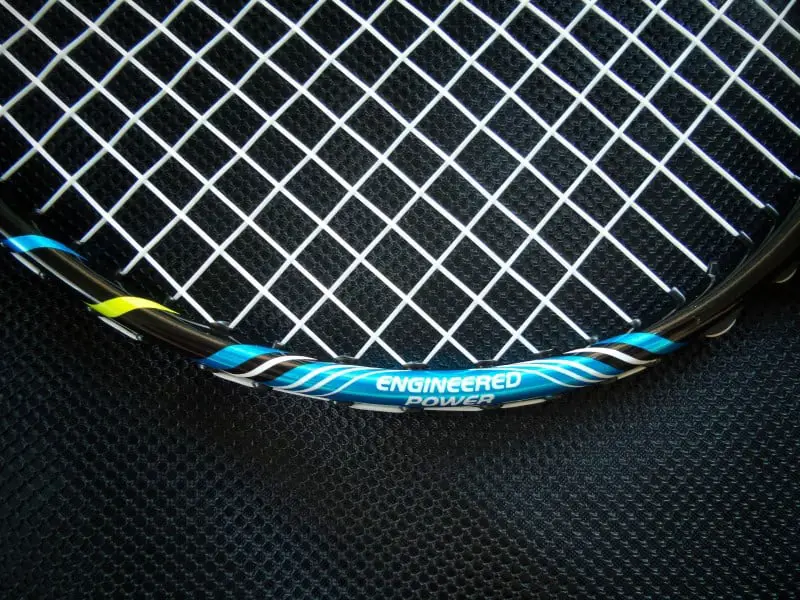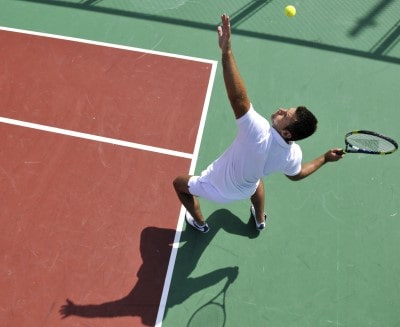The very first tennis racquet was created in the year 1500 and was made from wood that was strung with sheep guts. In 1874, a more modern version was created by Major Walter C. Wingfield that resembled the racquets that we use today, but it was still very clunky. Changes in tennis racquets today mostly deal with the materials used to craft them.
How long do the strings on a tennis racquet last? It varies. The life of tennis racquet strings depends on how often they are used, what the strings are made from, and the style of play they are used for. Tennis pros restring every single day, while more casual players may do it a couple of times a year.
This article will tell you everything you need to know about caring for tennis racquet strings. You will learn about the signs of wear to look out for, care instructions, as well as which types of strings are available and whether they are worth using.

Types of Tennis Racquet Strings and How Long They Last
Polyester is the most common type of string used for tennis racquets around the world, but there are some other types of string out there.
The various types of tennis racquet strings and their characteristics are explained in the following chart:
| Name of String | Material | How Long Do They Last? | Pros | Cons |
| Synthetic Gut | Nylon (composed of a single filament) | 1-2 Games | Cheap to make and purchase | Materials are not strong, and won’t last very long |
| Natural Gut | Animal intestine | It varies | More resilient, better tension, softer than other materials, remains soft | More expensive to produce |
| Multi-Filament | More than one filament, usually made of nylon, but could also include polyurethane, Zyex, Veotran, Kevlar | Varies depending on materials used | More robust depending on the filaments used | Using more than one filament comes at a cost, meaning it could be very expensive |
| Nylon | Nylon and wear-resistant coating | Varies | Nylon gives a good bounce; it is cheap to produce | It does not last long at all, especially if you don’t use wear-resistant coating |
| Polyester | Polyester | Varies depending on play style | Polyester is long-lasting, is beneficial for heavy topspin | Tension holding ability is not great |
| Kevlar | Kevlar | Varies on strength of Kevlar used | String is durable, hence the name | There is not as much lesion |
| Vectran | Vectran + Nylon | Varies | Mixing the two ingredients works well together | Can be expensive |
| Zyex | Zyex | Not long | Compared to natural gut strings, but synthetic | The durability is not great |
| Polyolefin | Polyolefin + other materials | Not long | It offers great control over the ball | Does not last very long |
| Metal Wire | Wire | Very long | Robust | Offers no bounce, flexibility, and is not widely available |
Note: Information in the above chart is according to “How to Choose Tennis Strings.”
Some of these strings are no longer used very often, but it’s always good to know they exist. With so many types of strings to choose from, you are sure to find a string or combination of strings that works for you. You can wrap another type of string around the string you have on your racquet, allowing you to customize the strings on your tennis racquet.
You can read more about tennis string reviews here.
Tips to Make Your Tennis Racquet Last Longer
Tennis racquets are not cheap and restringing them can come at a high cost. That’s why it is always best to know how to make your racquets last longer.
Some tips to keep your tennis racquet and its strings in tip top shape are:
- Restring your racket once or twice a year at the very least.
- A popular “rule of thumb is to restring the racquet as many times in a year as you play every week.”
- Use thinner strings if you don’t usually break your strings. This will give you better resilience and spin control.
- Make sure the temperature is regulated because high temperature environments can make strings lose tension.
- Cold temperatures make strings brittle and more likely to break.
- Each racquet has its own tension range, which you can find in the literature that comes with the product. Pay attention to this to be sure you are doing the right thing.
- If you opt for a durable polyester string, be sure to reduce the tension by around 10 percent. This is because polyester is not very stretchy, and it could result in an arm injury or damage to the racquet.
- The higher the tension in the strings means the more impact in your arm, so be sure to make the right call when it comes to tightening it.
- Adjust the tension and practice to find the best level for your play style.
Note: Above tips are adapted from “4 Ways to Give Your Tennis Racquet a Long Life.”
If you follow these tips, your tennis racquet should be in fighting shape for longer, allowing you to worry about beating your opponent as opposed to what is going to happen to your racquet.
Why Should You Re-String Your Tennis Racquet?
The strings on a tennis racquet can be the deciding factor on how well the game is played. If you want to be sure that your tennis racquet is performing at its best, it is wise to ensure the racquet is re-stringed as needed. This will help you to avoid disappointment when it comes to game time.
Here are some other things that could happen if you don’t re-string your tennis racquet:
- Injury to your arm or leg
- The ball could go through a hole in the string
- The strings lose tension every time they touch a ball
- The strings stretch more after every impact
- Ball stays on stretched strings for longer, meaning it will not act the way you expect it to
Perhaps the most problematic result of not re-stringing your tennis racquet is how the ball can stay on the strings for longer when playing. This means that the ball will go higher than you expect it to, and likely in a different direction to what you want it to go. If you are competing against someone, you must be able to tell where the ball is going when you hit it.
In tennis, power is necessary to push the tennis ball into the right direction. If you lose that, then the game becomes unpredictable, so it is always best to make sure your strings have been tightened.
Another factor to consider is the chance of injury. If you are forced to make a sharp move to try to get control of the ball after having issues with the strings, you could cause an injury to your arm or leg. Sharp turns can be difficult to pull off, but if your focus is on the ball, then there’s a chance an injury could occur.
While considering injuries, it is also possible to injure the other player or people in the audience. It may not sound likely but if a tennis racquet is not maintained, it can be harmful to others around. It’s best to make sure you are using durable materials that will not fall apart.
In Conclusion
There are many factors to take into consideration when it comes to your tennis racquet strings, but only you will be able to tell when your racquet is not as good as it once was. That should be the moment you decide to make some changes, whether that means tightening the strings or replacing the strings entirely.
If you pay attention to your racquet, then you will know when to act and what is the best course of action.


